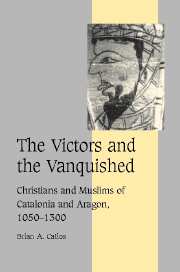Book contents
- Frontmatter
- Contents
- List of figures
- List of maps
- List of tables
- Acknowledgments
- Note on the citation of sources, dates, places, and names
- Glossary
- List of abbreviations
- INTRODUCTION
- Part I Muslim domination of the Ebro and its demise, 700–1200
- Part II Muslims under Christian rule
- Part III INDIVIDUAL AND COMMUNITY IN THE CHRISTIAN EBRO
- Conclusions
- Appendices
- APPENDIX 1 CURRENCY OF THE THIRTEENTH-CENTURY EBRO REGION
- APPENDIX 2 TOPONYMICAL VARIANTS IN ARCHIVAL DOCUMENTS
- APPENDIX 3 RULERS OF THE “CROWN OF ARAGON,” 1050–1300
- Select bibliography
- Index
- Cambridge Studies in Medieval Life and Thought Fourth series
APPENDIX 1 - CURRENCY OF THE THIRTEENTH-CENTURY EBRO REGION
Published online by Cambridge University Press: 08 January 2010
- Frontmatter
- Contents
- List of figures
- List of maps
- List of tables
- Acknowledgments
- Note on the citation of sources, dates, places, and names
- Glossary
- List of abbreviations
- INTRODUCTION
- Part I Muslim domination of the Ebro and its demise, 700–1200
- Part II Muslims under Christian rule
- Part III INDIVIDUAL AND COMMUNITY IN THE CHRISTIAN EBRO
- Conclusions
- Appendices
- APPENDIX 1 CURRENCY OF THE THIRTEENTH-CENTURY EBRO REGION
- APPENDIX 2 TOPONYMICAL VARIANTS IN ARCHIVAL DOCUMENTS
- APPENDIX 3 RULERS OF THE “CROWN OF ARAGON,” 1050–1300
- Select bibliography
- Index
- Cambridge Studies in Medieval Life and Thought Fourth series
Summary
Christian money in the thirteenth-century Ebro was modeled on Roman coinage: the solidus (sueldo, sou), equivalent to one-twentieth of a libra, was divided into twelve denarii (dineros, diners). Each of the main constituent territories of the Crown minted coins. Those of Aragon (Jaca) and Catalonia (Barcelona) were the most common, and fluctuated in value in relation to one another. For instance, in 1247 eighteen denarii barcelonenses were equal to fifteen denarii jaquenses. These were minted, unlike the libra jaquensa, which was a money of account. The dupla referred in principle to an Almohad (later, Naṣrid) issue, but the word was used generically for gold coins. Other common monies included the silver mark (approx. 60 sol. jaq./72 sol. barc.), the Moroccan mazmudina yucifia (approx. 5 sol. jaq./6 sol. barc.), the Castilian mazmudina (approx. 4 sol., 4 den. jaq./5 sol., 4 den. barc.), the maravedí alfonsí (approx. 7 sol., 6 den. jaq./9 sol. barc.), the morabetin (approx. 10 sol., 8 den.jaq./ 12 sol., 9 den. barc.) and the besant (approx. 2 sol.,14–20 den. jacc./3 sol., 2–6 den. barc.).
In terms of circulation, solidi of Barcelona dominated the area of modern Catalonia and eastern and southern Aragon (including Fraga, Alcañiz and Teruel), whereas Jaccan coins were most current in old Aragon, the upper Ebro, and the valleys of its tributaries, including the Jalón (see the map in A. Ubieto, Arbeta, Historia de Aragón. Creación y desarrollo de la Corona de Aragón [Zaragoza: Anubar, 1987], p. 158).
- Type
- Chapter
- Information
- The Victors and the VanquishedChristians and Muslims of Catalonia and Aragon, 1050–1300, pp. 409Publisher: Cambridge University PressPrint publication year: 2004



